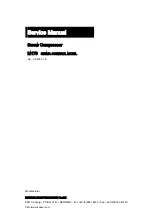
Book 35393065 (7/02)
37
( )
FUEL TANK
CLEAN fuel in the fuel tanks is vitally important and
every precaution should be taken to ensure that only
clean fuel is poured or pumped into the tank.
When filling the fuel tank on this unit, by methods other
than a pump and hose, use a CLEAN non--metallic
funnel.
BATTERY
Keep the battery posts--to--cable connections clean,
tight and lightly coated with a grease. Also the
electrolyte level in each cell should cover the top of the
plates. If necessary, top--up with clean distilled water.
FASTENERS
Visually check entire unit in regard to bolts, nuts and
screws being properly secured. Spot check several
capscrews and nuts for proper torque. If any are found
loose, a more thorough inspection must be made.
Take corrective action.
RADIATOR
NOTICE
The use of water alone in this engine can result in
major engine failure.
HOSES
Each month it is recommended that all of the intake
lines to and from the air cleaners, the engine cooling
system hoses and all of the flexible hoses used for air,
oil, and fuel be inspected.
To ensure freedom from air leaks, all rubber hose
joints and the screw--type hose clamps must be
absolutely tight.
Regular inspection of these
connections for wear or deterioration is necessary.
Premature wear of both the engine and compressor is
ASSURED whenever dust--laden air is permitted to
enter the engine’s combustion chamber or the
compressor intake.
The flexible hoses used in the fuel, oil and air lines on
these units are primarily used for their ability to
accommodate
relative
movement
between
components. It is important they be periodically
inspected for wear and deterioration.
It is also
important the operator does not use the hoses as
convenient hand hold or steps. Such use can cause
early cover wear and hose failure.
NOTICE
Piping systems operating at less than 150 psi
(1050 kPa) may use a special nylon tubing. The
associated fittings are also of a special “push--in”
design. If so, features are as follows:
Pulling on the tubing will cause the inner sleeve to
withdraw and compress, thus tightening the
connection. The tubing can be withdrawn only while
holding the sleeve against the fitting. The tubing can
be removed and replaced numerous times without
losing its sealing ability.
To install the nylon tubing, make a mark (with tape or
grease pencil) approximately 7/8 inch from the end of
the tubing. Insert the tubing into the sleeve and
“push--in” past the first resistance to the bottom. The
mark should be approximately 1/16 inch from the
sleeve, for the 3/8 inch O.D. tubing; 1/8 inch for the
0.25 inch O.D. tubing. This will ensure that the tubing
is fully engaged in the sealing mechanism.
NOTICE
The oil filter must be replaced every 500 hours of
operation or three (3) months, whichever comes
first. On new or overhauled units, replace the ele-
ment after the first 50 and 150 hours of operation;
thereafter, service the oil filter every 500 hours.
To service the oil filters it will first be necessary to shut
the unit down. Wipe off any external dirt and oil from
the exterior of the filter to minimize any contamination
from entering the lubrication system. Proceed as
follows:
Summary of Contents for P130WJDU
Page 28: ...Book 35393065 7 02 28 Figure Z...
















































